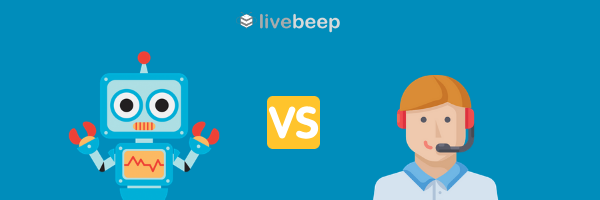When should we use a chatbot system and when a human contact for our customer service?
A misunderstood concept is that chatbots exist to replace the human team in the customer service departments. This will never happen for most businesses. We know that the greatest use of chatbots is to attend to the most repetitive queries, which allows the (human) team to avoid boring tasks and help them prioritize more strategic job.
So, when and where is it better to use a chatbot instead of a human?
Chatbots and the 80% – 20% rule
Frequently asked questions (FAQ’s) in customer service represent approximately 80% of the support work. The 20% left are usually more specific questions or problems. It can be different on each company, but it is true that in all of them there is a big volume of FAQ’s. They are usually easy to answer and, therefore, can be easily solved without human intervention.
That’s why chatbots are mainly developed to deal with frequently asked questions in customer service department.
In that case, the efficiency is more important that the value in the human component of the interaction. In fact, according to Harvard Business Review, “84% of customers prefer a direct solution to their problem” without personal additions.
Companies with a lot of volume of these repetitive questions will perceive a greater value of chatbots and they will reduce the workload of the human team while improving the user experience by solving the problem immediately. Customers save time and they can resolve the problem by themselves and keep interacting with the site or application. So, the use of bots decreases the amount of work of the customer service team and they can get a much faster response to solve the problem.
However, human interaction is necessary when we talk about solving specific problems that are more complex and that require more time. Not only because of the complexity of the situation, but also because the customer needs to feel cared when she or he has the problem.
The key is to get more high-value interactions, both for chatbot or for human interactions.
The three situations in which human interventions get more success than chatbots
Deal with angry or dissatisfied customers. For example, if a customer is receiving an order out of time and asks you for his or her purchase, it would be recommended that a human answers the query to empathize with the situation and the problem. If you received a wrong or defective product, we recommend that you personally apologize and offer the best solution to avoid losing the customer.
Potential customer with clear purchase intention. For example, if a web user has a clear intention to buy, we must seize the opportunity to close the deal and do cross selling. In fact, if a loyal customer has returned to your website to buy something, do not hesitate to ask him or her to recommend you or offer a special discount for that.
Complicated or long problems to solve. It is a matter of “putting oneself in the shoes” of the clients and identifying what kind of problems are the most complicated to solve (or the longest). We must offer a well-trained human team to do so and accompany them during the solution process so that they never feel neglected.
If you use chatbots, always communicate it to your web users so that they know they are speaking to a robot and not to a human person, and if their problem requires human assistance, never deny it.
If in your company you are considering using chatbot technology to integrate it into your customer service, we recommend you always do an opportunity cost study first. In Livebeep we can offer you more information and a personalized development of your chatbot. Contact us to continue talking!



 Español
Español
